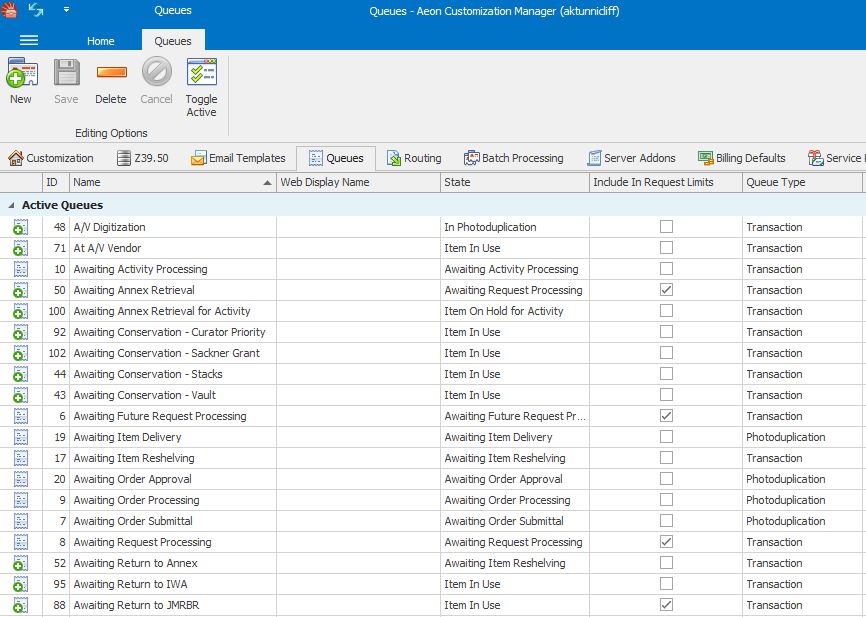https://www.atlas-sys.com/aeon
Reviewed by Anna Holland, Associate Curator, Iowa Women’s Archives, University of Iowa Libraries [PDF Full Text]
Aeon is part of the suite of library software supported by Atlas Systems, which also includes ArchivesSpace, ILLiad, and Ares. Aeon 5.2 was released in March 2023.
Aeon automates public service workflows in archives and special collections. Using this software, staff manage paging, use in multiple reading rooms, photoduplication, and activities such as class visits and exhibits. Aeon integrates with ArchivesSpace to allow patrons to make requests at the point of discovery and compiles usage statistics automatically. It utilizes a Microsoft SQL server, Windows-based staff client, and public web interface. The Aeon client interface has three main modules, each representing a core function: Reading Room, Photoduplication, and Activity. Within each, there are several customizable statuses, such as “Item in Use” or “Item on Hold,” that help staff move items through their workflows. Patrons’ online requests will appear on the client at the beginning of the Reading Room workflow. The Photoduplication module tracks patron orders, charging, and payment. The Activities module has advantages for teaching staff. For instance, once staff create an activity, they can attach an instructor’s patron account and allow them to add requests using the web interface. Staff can also upload requests with an Excel template and then clone the activity for repeating events.

Figure 1. The Aeon home screen displays requests in the Reading Room, Photoduplication, and Activity workflows along with the number of items currently in each status.
One of Aeon’s primary strengths is its customizability. Aeon installation includes a staff manager and a customization manager feature for workstations. The staff manager supports different levels of staff access to the client. Through the customization manager, staff can create email templates, add additional reading rooms, and adapt Aeon to local workflows. Using the customization manager, staff at my institution use Aeon for digitization and conservation workflows that include unique steps like “Awaiting Conservation – Curator Priority” and “At A/V Vendor.”

Figure 2. Editing templates and adapting Aeon to local workflows is easy with the customization manager.
Atlas BI, Atlas Systems’ reporting analytics tool, compiles request data. Staff can set date ranges and generate reports that count patrons, activities, photoduplication requests, and more. The client displays this data in pie charts, timelines, or spreadsheets, which staff can easily export to Excel or convert to a PDF.

Figure 3. Aeon automatically collects use data in Atlas BI. Its designer mode lets staff choose from several graph and map types when displaying data.
My institution integrates Aeon with ArchivesSpace, and the functionality, while not ideal, has improved considerably with the release of Aeon 5.2 and an updated ASpace fulfillment plugin. An Aeon button in ArchivesSpace allows patrons to make requests at the file and item levels of all finding aids. Aeon will pull data from ArchivesSpace such as the title, dates, box number, box location, and barcode to fulfill Aeon requests. However, human error still creates problems. Patrons frequently duplicate requests for single boxes by making a request for every file they plan to consult. Alternatively, patrons originating requests directly from their Aeon accounts often list multiple boxes in one request, which staff must then separate into individual requests. Both situations can create confusion for paging and reshelving. Staff take significant time fixing these issues in the client. Given all of this, I usually create patrons’ requests using the client on their behalf.
Aeon does not fully integrate with the collection like a standard integrated library system. Instead of tying each top container to a single-item record, Aeon treats each request as unique. This allows staff to create requests for a single box in two places at once. For instance, one item from a container may be in an exhibit while the rest of the box is being used in the reading room. But, because of the lack of single-item records, Aeon will not recognize a container by its barcode. As a result, staff cannot use the Aeon client to search for a box to see where it is or produce a record of its use.
Also, unlike many integrated systems in public libraries, Aeon does not put the same premium on patron privacy. While the American Library Association emphasizes explicit consent where patrons opt into data collection, Aeon automatically stores request history and does not offer patrons the choice to opt out. This could be helpful in a place where one missing document may go unnoticed for a long time. However, with no single-item records for top containers tied to all item requests, it is impossible for staff to use Aeon to search for a collection and see its past users.
Overall, Aeon is a powerful tool for improving workflow and patron service efficiency in a special collections and archives environment. It covers all main functions of archival public service while providing statistics, adequate training, and technical support. Atlas Systems could improve Aeon by fully integrating it with other products like ArchivesSpace and further considering how best to protect patron privacy. However, after using Aeon for nearly five years, I would recommend it to other archives and special collections institutions.